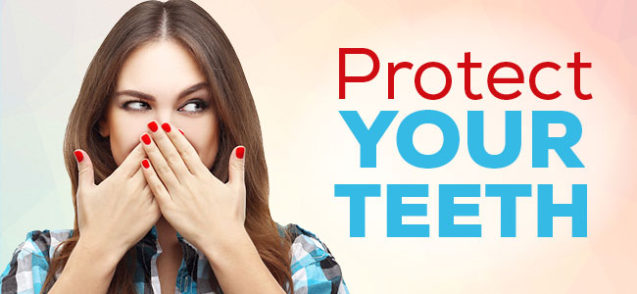Taking preventive measures to protect your teeth from decay is essential for maintaining your natural smile. While prevention includes maintaining good at-home oral hygiene practices and making it to your routine dental visits, there are additional steps you can take to help keep your teeth healthy, strong, and safeguarded against the harmful bacteria that leads to decay and cavities.
Some of the following preventive measures are commonly associated with protective treatments appropriate for children, but they can be just as beneficial for adult teeth. The next time you pop in for your regular exam, take some time to ask the doctor about whether they are right for you.
Sealants
Brushing and flossing cleans most of your teeth surfaces, but getting to all of the crevices — especially those located in the back molars and premolars — is difficult. Those tiny dips and pits are perfect for trapping food and bacteria, which often results in the formation of cavities.
Dental sealants provide a protective coating that keeps these areas free from food debris. They are made from a resin material that is used to coat the chewing surfaces of the back teeth. It is painted on and seals the nooks and crannies in the teeth, so that food and other plaque-causing materials that cause cavities are kept out.
The procedure for applying sealants is simple, painless, fast, and takes only one visit. First the decay is removed from your teeth, and they are thoroughly cleaned and dried. Next the sealant material is painted on the chewing surface. It will naturally bond to the tooth on its own; however, a special light may be used to speed the process, helping the sealant to harden in just a couple of minutes.
Fluoride Treatments
Fluoride is a naturally occurring mineral that can be found in both food and water. It aids in the prevention of tooth decay and cavities by making teeth resistant to the acids created by plaque and sugars. Fluoride is deposited on tooth enamel when you eat foods and beverages that contain it; it is lost when the acids produced by plaque and sugars eat away at the enamel of a tooth. Tooth decay occurs when the amount of fluoride lost outweighs what is being deposited.
Most often fluoride and its use in dental treatments is associated with children and the strengthening of their young, vulnerable teeth. Although fluoride is important for young children, it is also beneficial for adolescents and adults of all ages. In fact, new research indicates that fluoride’s role in fighting tooth decay as we age is just as important as its role in the strengthening and protection of newly developing teeth.
A fluoride treatment involves applying fluoride topically to teeth. The in-office fluoride treatment is quick and painless, and it involves applying fluoride in the form of varnish, gel, or foam directly onto the teeth. This can be accomplished by wearing a mouthguard filled with the foam or gel or by having varnish painted directly onto your teeth.
Hygiene Services
In addition to sealants and fluoride treatments, there are two important hygiene services that can improve your chances of avoiding decay, cavities, and tooth loss.
Periodontal treatment: This treatment prevents the progression of periodontal disease and returns teeth and gums to a healthy state.
Professional teeth cleanings: Having your teeth cleaned regularly helps prevent gingivitis, tooth decay, and loss of enamel from teeth. Some of the services included during your regular cleaning include:
- A review of your dental and medical history
- An oral cancer screening
- An evaluation of your overall oral health
- X-rays to detect decay
- Removal of stains, plaque, and tartar
- Polishing of all teeth
- At-home oral health education and instruction
Keeping your natural smile for a lifetime is possible when protective measures are taken and the proper dental care is received. Your oral health is our top priority, and making sure your teeth stay healthy and beautiful is our mission. Call us today to find out more about how we can help protect your smile against decay.
More
By admin
15 Jun, 2016
Dental Health, Dental Tips, General Dentistry, General Health, Lifestyle, Oral Health
brushing, children's dentistry, flossing, oral hygiene, pediatric dentistry

Even though baby’s first teeth are temporary, getting an early start on excellent dental hygiene practices, including both brushing and flossing, is essential to a lifetime of good oral health. Dental decay is one of the most common childhood diseases. According to the Centers for Disease Control and Prevention (CDC), 42% of children ages 2 to 11 have had cavities in baby teeth, and 21% of those ages 6 to 11 have had cavities in permanent teeth.
Tooth decay not only poses a threat to tiny teeth, it can negatively affect a child’s whole health, as well as how they feel about themselves. One of the longest-lasting benefits of a healthy smile during childhood is the foundation for a healthy self-image.
Start Early
Brushing
You should begin cleaning a baby’s gums after each feeding with gauze or a soft cloth starting immediately after birth. As soon as the baby teeth begin to erupt, you can use a soft-bristled child’s toothbrush to clean your toddler’s teeth. Continue brushing for them until they have the dexterity to take over (approximately around 6 years old).
Flossing
Flossing is difficult for small, untrained hands. Your child doesn’t have to begin brushing right away, but once their tooth surfaces are almost touching, plaque and food begin to settle in between teeth, which can lead to gum disease and tooth decay. At this point, they should begin learning to floss and doing so at least once a day.
Teaching your child to floss can be tricky. The following steps will help you get them off to an easy start.
- Choose soft, flavored floss that’s gentle on your child’s gums and tastes good.
- Measure out a length of floss that runs from your fingers to your elbow.
- Wrap the floss around your child’s fingers as you would your own when flossing, but make sure it isn’t so tight that it cuts off circulation or causes any discomfort.
- Gently guide your children’s fingers, and show them how to glide the floss between the teeth.
- Show them how to make the floss into a C shape and curve it carefully beneath the gum line.
- Make sure they shift the floss to the next finger between each tooth so that they use fresh floss in each space.
At first flossing may be difficult and even frustrating for your little one. They may not like wrapping the string around their fingers, or they may just find changing the wrap of the floss too difficult. Fortunately, there are a wide variety of child-friendly floss sticks available in different colors and flavors. They come in packs of 50 to 100, giving your little one room for error. Make sure they dispose of each floss stick after use.
If your child is having an extra difficult time learning to floss, or if they have braces, consider trying the Waterpik Water Flosser for Kids. It’s made with a simple design that makes flossing easy for children over the age of 6. It is child safe and designed for small hands, so that your child’s frustration will be alleviated and their teeth will get cleaned properly.
As your children develop, they will be able to execute flossing with ease and can decide whether to continue using their flossing stick or a Waterpik, or whether to take the more traditional route.
For more information and help educating your child on the importance of their oral hygiene practices, call us today. We prepare you with information and instructions on how to clean your child’s teeth, as well as how to teach your child to clean their own teeth — or we can teach them with you.
More
By admin
01 Jun, 2016
Cosmetic Dentistry, Dental Health, Dental Tips, General Dentistry, General Health, Lifestyle, Oral Health
cold sores, dental hygiene, dental tips, oral health

“Summer loving had me a blast, oh yeah. Summer loving happened so fast…” —Grease, Summer Nights
Its’ the stuff dreams and movies are made of: summer love. Warm summer nights, afternoons at the beach, vacations to the Caribbean—whether you are hoping to meet your next crush or are looking forward to romancing your long-time love —summer is sure to heat things up.
Did you know that June 19th is National Kissing Day? Are you ready to get romantic? A healthy mouth and kissable lips are key to having the summer you have been dreaming of. From making sure that your teeth and gums are in top condition, to protecting and caring for your lips so they stay soft and blemish free, there are several measures you can take to stay romance ready all summer long.
Tips for a healthy mouth
The best way to make sure that your mouth stays healthy and halitosis free is to stay on top of your at-home oral hygiene practices. Don’t forget the basics:
- Brush twice a day
- Rinse after brushing
- Floss daily
Take your oral care to the next level. You already know you need to set up routine visits with your dentist to keep your teeth in top condition. Consider the following treatments for extra protection.
- Regular fluoride treatments can help keep your teeth strong, especially if your water source is fluoride free.
- Dental sealants can protect your teeth from decay. Consider having them applied to your back teeth.
- Along with your routine cleanings, try a whitening treatment so that your healthy smile shines through.
Taking care of your lips
If you are concerned about keeping lips kissable, consider the following tips:
- Apply balm to your lips before you wash your face. It protects them from drying elements in your cleanser that can cause them to chap and flake.
- Use a humidifier at night to keep your skin (including your lips) moisturized.
- Don’t pick at flakey lips. Instead, remove the extra skin with a lip exfoliator or combine sugar and honey for a natural exfoliator.
- Protect your lips from the rays with sunscreen.
- If you wear lipstick, try to find one with vitamin E or Shea butter in it.
- Stay hydrated with water. Drink. Drink. Drink!
- If your lips are chapped, avoid spicy foods, foods high in citrus, and salt. They will only cause lips to dry out more.
- Avoid licking your lips. The acids in your saliva can cause irritation.
When cold sores appear
Nothing kills the mood like a cold sore. They are painful, unsightly, and contagious. They make talking and eating uncomfortable, and can be confidence busters when trying to woo someone.
Cold sores heal over the course of seven to 14 days, but true love doesn’t wait. There are over-the-counter treatments that come in the form of messy ointments and creams that make the lesions more noticeable when applied while only reducing the healing time by 1 to 2 days. Or, you can talk to your dentist about getting immediate results with laser therapy.
Laser therapy uses photonic laser energy to destroy the active virus responsible for the oral lesions and is accomplished quickly and comfortably without the need for anesthetic. Often, those who seek treatment at the first signs of the virus (tingling, and light burning sensations) don’t develop sores. However, if sores have already erupted the progression is stopped, and the appearance and discomfort is greatly decreased. Your lips will immediately appear significantly clearer, and be completely lesion-free in typically one to two days allowing you to feel more confident about getting cuddly.
The benefits of laser therapy include:
- Profound and immediate pain relief
- Treatment stops lesions’ progression immediately
- Significantly reduces healing time
- Treatment time of just a few minutes
- Treatment is painless and can be conducted with out anesthetic (it feels like warm air blowing)
- After treatment, sores reoccur with less frequency and less intensity at the same location
- Treatment is affordable and can be insurance reimbursable
With a little extra effort and support from your dental care providers, this summer is sure to be the best yet. Don’t let chapped lips or bad breath stand in the way of getting cozy under the summer night sky with that someone special. Call us today to schedule your next appointment or a cleaning and get your summer started off right.
More
By admin
20 May, 2016
Dental Health, Dental Tips, General Dentistry, General Health, Lifestyle, Oral Health
dental hygiene, dental tips, oral cancer, oral health, preventative care

Speaking, eating, and smooching — these are all daily activities that draw attention to your lips. You most likely catch a glimpse of them every time you look in the mirror throughout the day, like when you brush your teeth during your morning routine and then again before going to bed. With their high visibility, you might guess that identifying lip cancer in its earliest stages would be common, but you might be surprised at how often early signs go unnoticed.
Skin cancer is the most common type of cancer in the U.S., and according to the American Dental Association, 41,000 Americans will be diagnosed with oral and throat cancers this year. With 60% of the U.S. population visiting the dentist each year, where there mouths are closely examined and oral cancer screenings are done routinely, the dental community is the first line of defense for early detection.
What Is the Difference Between Lip and Oral Cancer?
Lip cancer is one kind of oral cancer. Simply put, cancer is the rapid and uncontrollable growth of invasive cells that damage surrounding tissue. When this occurs on or in the mouth, it is referred to as oral cancer. A notable difference between lip cancer and cancer that occurs inside the mouth and throat is the added risk factor of prolonged exposure to the sun. Lip cancer is often caused by the harmful effects of ultraviolet light, and the lower lip specifically has the greatest risk because it has more exposure to the sun.
Risk Factors
While sun exposure increases the likelihood of suffering from lip cancer, there are other factors that increase your risk for oral cancer, most of which are avoidable.
- Tobacco: Tobacco use of any kind increases your chances of getting oral cancer.
- Alcohol: Heavy alcohol use and abuse has been found to be a risk factor.
- Sun exposure: Individuals who have regular, prolonged exposure to the sun are more likely to be diagnosed with cancer of the lips.
- HPV: HPV is tied to the development of cervical cancer and is also a risk factor for oral and oropharyngeal cancers.
- Dentures: Though the connection is debated, some believe that poorly fit dentures that cause long-term irritation of the mouth lining may lead to cancer. It is important that patients who wear dentures have the fit checked regularly, along with a regular oral cancer screening, to minimize their risk.
Signs of Oral Cancer
Cancer of the mouth reveals itself as a growth or sore in the mouth or throat that doesn’t go away with time. Other symptoms include:
- Red or white patches on the lining of the mouth or tongue
- Swelling or thickening of areas inside the mouth
- Unexplained bleeding
- Sores on the face, neck, or mouth that do not heal
- Chronic sore throat
- Hoarseness
- A change in the way your dentures fit
Though early detection is key to surviving oral cancer, prevention should always be the top priority.
Oral and Lip Cancer Prevention
There are some simple preventive steps you can take to minimize your risk of getting oral cancer:
- Good oral hygiene: Gum disease and tooth decay introduce infections into your mouth. This increases the risk of getting oral cancer. Make sure to brush, floss, and rinse daily.
- Make your routine visits: Your routine visits to the dentist are important. Our providers do more than make sure your teeth are clean; they are skilled at detecting the earliest signs of cancer, and they examine you thoroughly at every visit.
- Don’t engage in high-risk behaviors: Avoid smoking and smokeless tobacco, and minimize your consumption of alcohol.
- Use sun protection: If you are going to be spending time in the sun, use a broad-spectrum lip balm and sunscreen for your face and exposed skin. A broad-rim hat is an excellent choice for extra protection of face and lip areas.
Performing a Self-Examination
While performing a regular self-examination is a must, your own regular self-exam should not take the place of a routine dental visit. You may not be able to adequately see signs and symptoms that your dentist can easily identify.
To perform your at-home self-exam, take the following steps:
- Stick out your tongue as far as you can and examine all sides and the underneath for lumps and discolored patches.
- Use your fingers to feel the inside surface of your cheeks and your lips for bumps or sore areas.
- Inspect the floor of your mouth for lumps as well as white and red patches that shouldn’t be there.
- Inspect the top of your mouth, and then depress your tongue and check your tonsils for abnormal enlargements, redness, symmetry, or bumps.
- Inspect your neck for enlarged lymph nodes or irregular bumps by palpating it with your fingers.
Visiting your dentist for regular examination significantly improves the chances that abnormalities in your mouth will be caught and examined, greatly improving your chances of successful treatment should any abnormalities be cancerous. If you have questions or concerns about oral or lip cancer, call us today. We can provide you with the information you need and schedule a reassuring oral cancer screening for you as well.
More

Motherhood is both wonderful and challenging. Most women agree that the only way to truly understand what being a mom is like is to become one. Once you have had children, they become your main focus, the purpose behind everything you do…and don’t do.
It’s not uncommon for women to neglect themselves after having a baby. From missing the daily shower to going an extra month or two without a haircut, it’s natural for mothers to reroute all of their resources to their child or children, whether that be time, money, or energy. But could that self-neglect be having a negative affect that extends beyond Mom?
Healthy Mom Equals Healthy Child
According to a study published in the Journal of Dental Research (Jan. 19, 2011)1, moms’ oral health predicts their children’s oral health. This 27-year-long study found that if mothers had poor oral-hygiene practices while their children were young, the children had a higher rate of dental caries and poor overall oral health as adults. The study was conducted in New Zealand and consisted of 835 mothers who participated in a self-rated survey and 1,000 children who were examined at age 5 and then again at 32 (more than 900 examined at this time).
The results were overwhelming. Almost half of the children with mothers who had poor dental health suffered from tooth decay and eventual tooth loss as adults.
Bad News or Good?
Initially, these results may sound like bad news, but they support the belief that when moms take time to care for themselves, they are also taking care of their children — a little relief from guilt for mom.
Oral hygiene and dental care should not be seen as optional for mothers; they are crucial to Mom’s self-esteem and overall health, as well as for the children’s health and well-being.
So what does putting the right amount of time and energy into dental care mean for Mom?
- Making sure to brush at least twice a day with fluoride toothpaste
- Flossing every day
- Minimizing the amount of sugary foods that are consumed
- Scheduling and attending regular checkups and cleanings
Some common oral health conditions can be staved off with good oral-hygiene practices and regular checkups:
Periodontal disease: The best way to avoid gum disease is by sticking to your at-home oral-hygiene routine. Flossing is particularly important. When plaque and tartar remain on teeth, a mild form of periodontal disease can occur, called gingivitis, in which the gums bleed and become red and swollen. Gingivitis is reversible, and it can be treated. However, when left untreated, the gum disease worsens, leading to an advanced form called periodontitis that can cause severe damage to the soft tissue that supports the teeth, resulting in infection and eventual tooth loss.
Oral cancer: According to the American Dental Association, 41,000 Americans will be diagnosed with oral and throat cancers this year. Oral or mouth cancer reveals itself as a growth or sore in the mouth or throat that doesn’t go away with time. When you come into our office for your regular checkup, we provide a potentially life-saving oral cancer screening. Our oral cancer screenings consists of a verbal, visual, and physical examination, and they significantly increase your chance of a full recovery should cancer be found. We are your first line of defense for early detection.
Having a healthy mouth and a beautiful smile are key to Mom feeling good about herself. Whether the special mother in your life is yours, someone you know, or you yourself, consider treating her to a teeth-whitening treatment. Sometimes having brighter teeth can give Mom that boost she needs. Feeling good about yourself is important, especially when life gets hard. As your family dentist, we understand that while dark and stained teeth can be healthy, they can also make you look tired, worn down, and older than you really are. Mom deserves better.
Modern-day whitening treatments are fast, effective, and affordable, and they can whiten teeth up to 14 shades brighter. There is no quicker way to make Mom feel as amazing as she is. And remember, when Mom is happy, everyone is happier!
Call today to find out more about how you can help Mom and the whole family stay healthier and happier.
1. http://jdr.sagepub.com/content/90/5/672
More





